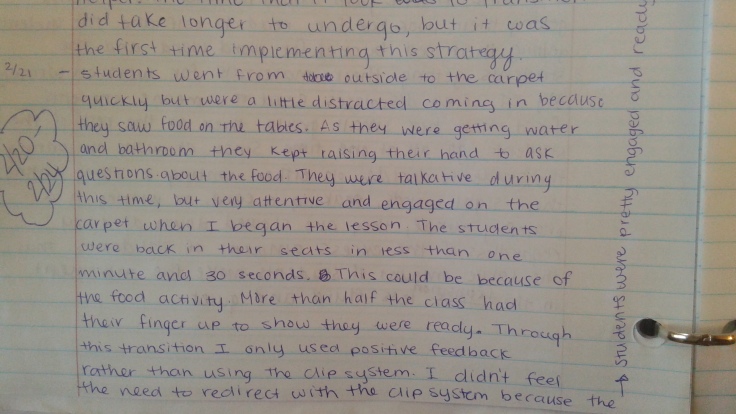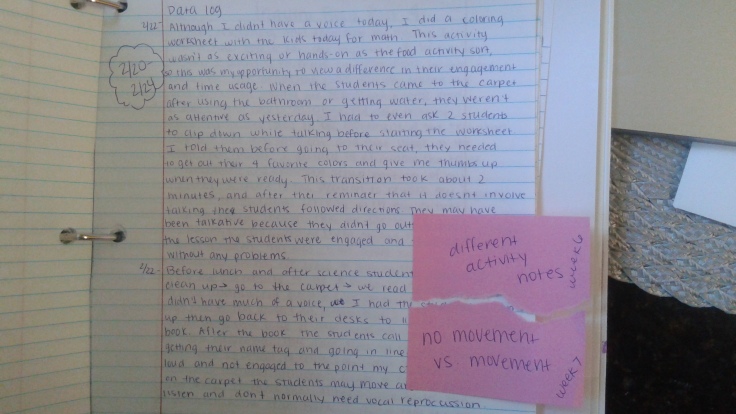Since the last post, there has been two weeks that have transpired. These two weeks have been the beginning of using my new reworked inquiry wondering of: how does movement transitions impact time usage and student engagement in the lessons that follow? From the last post, I was wanting to try different variations within the transitions that occur in my classroom. Within this my first action was to see how using no movement in the transition impacted the engagement of the students verses using movement. Seeing the difference between how no movement influences the students engagement would allow me to compare the data to how their engagement was when using movement. I did this though making observational notes to see how students react. In addition to the notes, I added to my time-engagement chart which would allow me to see the pattern of the time usage in combination with the engagement ratio. Additionally, I was curious if there was any influence in the way the students reacted during the transitions when different types of activities were used in the lesson. Implementing different activities after the movement transition gave me the ability to observe the influence that it could be having on my data. Observing if there is any difference would allow me to see if the engagement and time usage is truly from the transition.
The implementation of the different after transition activities showed me that although the students were a little more talkative with the activity that wasn’t as hands-on and “exciting”. One of the lessons I had made observational notes in was during a hands-on shape sort. In this lesson, the students were sorting food that was shaped as different 3-D shapes. When the students came in from being outside and were going to the carpet to wait for instruction, they noticed the food on the table and were a little distracted from that. However, once getting to the carpet they perked up and were awaiting me instruction quietly. After my review of 3-D shapes we had been learning about we began the next transition. The transition from the carpet to the tables was quick and quiet. The students were ready to begin the lesson within 1 minute. They were engaged and focused on me to give the next instruction. There weren’t any students that slowed down the transition or didn’t follow directions. I was thinking that this was due to the food activity that they would be doing. However, the following days’ math lessons proved me wrong. The next set of observational notes was on the following day, in which the students were doing a far less exciting math lesson. This lesson was using coloring paired with the math concept of 3-D shapes. On this day, I didn’t have much of a voice so I was a little concerned my expectations wouldn’t be as clear, thus leaving the students in a hectic state of mind when transitioning. When the students came in from being outside, they went straight to the carpet. Unlike the prior day, the students weren’t distracted by anything on their tables when coming into the room. Even though they weren’t as attentive as yesterday and I had to ask two students to clip down this was before I was able to give instruction for the math lesson. Once I had given instruction to get out four of their favorite colors then give me a thumbs up and sent the students on to transitioning to their tables, the total time of the transition took about 2 minutes. This 2 minute time did include a reminder that it doesn’t involve talking. After looking at the two sets of observation notes, I did see a difference in the engagement and time, however, the time difference and the engagement seems like such a minute difference that I don’t think the type of activity after the transition makes that big of a difference in the impact of the engagement and time usage. Knowing this I can focus more on just the transition rather than what the students would be doing after the transition. I won’t be worried about the data I will be collecting on the students engagement and time usage when doing movement transitions being skewed because of this variable. It seems as though the data that I will be collecting is solely due to the transition, which is beneficial for when I go to make claims in my inquiry.
Another set of data that I collected was observation notes of when I used no movement to transition from one activity to the next. This difference was in between lunch and science. During this time we normally transition and move to the carpet to read a book (if time permits) then line up for lunch. In this particular day I still was lacking a voice and decided to just have the students clean their science materials up and return to their seats. Since there was still time, I played a myon book instead of reading one on the carpet. After the book, the students remained in their seats and the lunch helper called the names to line up for lunch. The students were loud and not engaged to the point where my CT had to yell and remind the students the expectations. Normally when we’re on the carpet, the students may move around, but they listen and don’t normally need vocal repercussion. This set of data I think was shows a key factor into understanding my wondering. The difference in the students behavior and their ability to be engaged enough to listen to the lunch helper call names shows that the movement within the transition does impact the students. In this case, the students were antsy to move and get their energy out in one way, which turned to a room full of talkative students disregarding the expectations. This learning was important in my inquiry because it gives me the ability to establish a claim through the collection of more data focusing on this.
The next actions that I will be taking over the next couple of weeks that remain in my internship include collecting more data focusing on the no movement concept that I observed this week. Also I would like to start implementing different “switching activities” that I learned about while researching my wondering topic (Sainato, 1990, p. 290). This strategy consists of requiring the students to complete a task of some sort as a preparation for the next lesson or activity. For example, having the students go to the carpet in between lessons would be considered a switching activity. However, instead of the carpet switching activity, I will be using something inc combination or instead of. After conducting my research, this was one of the actions I was excited to implement because I think I some good claims could derive from them. From the data I have collected, I still wonder what the students will think about the different “switching activities” and using no movement when transitioning. I think this may be the last action that I plan to end with for my inquiry.


References:
Sainato, D. M. (1990). Classroom transitions: Organizing environments to promote independent performance in preschool children with disabilities. Education and Treatment of Children, 13(4), 288-297.
Leave a comment